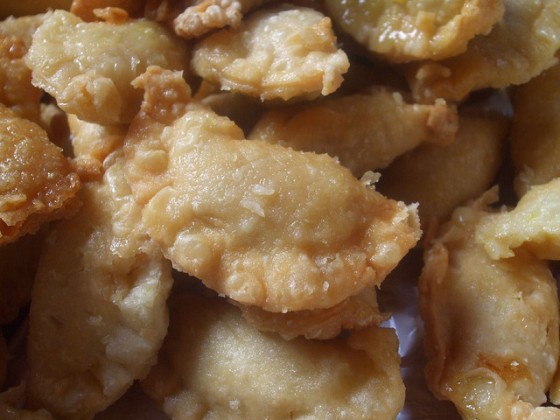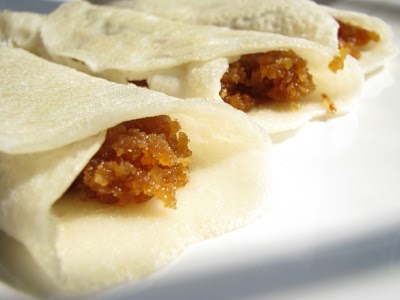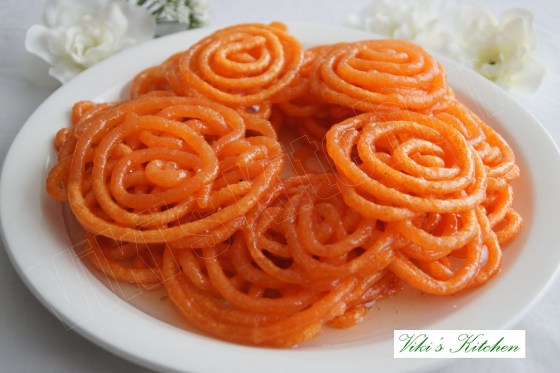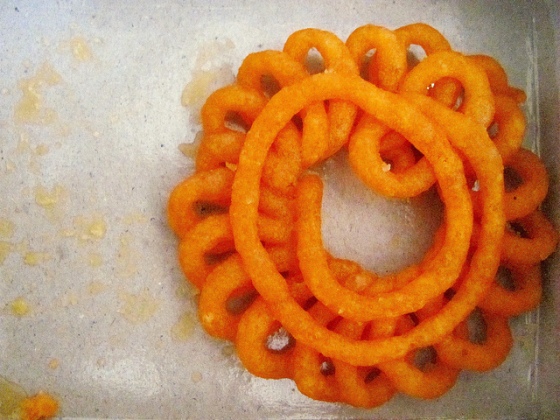To understand the variety of shape of sweets, I took the following sweets for my references:
Chandrapuli: Moon shaped sweet with khoya stuffing.
One of the most juicy and mouth watering sweet made with flour and milk (khoya). A Bengali specialty. Server usually during special festivals. It takes time to prepare but it is worth it.
——————————————————————————————————————
Patishapta: Rice crepes with coconut filling.
Patishapta … the most made Pithe in Bengali homes I guess. Traditional Patishapta is made with a rice flour batter and fresh coconuts and jaggery …. but many people make it with a batter of maida and sooji too. But come winter, every Bengali has to taste the Patishapta once. When made or had with fresh date palm jaggery, the Patishapta
evokes wonderful memories of childhood in every Bengali. (Picture courtesy: http://kichukhonn.blogspot.in/)
——————————————————————————————————————
Lobonga Lotika: Crusted mishti envelopes filled with khoya and stuck with a clove (laving/lobongo).
——————————————————————————————————————
Amriti: Similar to jalebis but much sweeter and of a typical design.
——————————————————————————————————————
Malapua: Circular fried sweets in sugar syrup.
Malapua (Bengali: মালপোয়া, Oriya: ମାଲପୁଆ) or amalu (Oriya: ଅମାଲୁ) is an Indian pancake served as a dessert or a snack. It’s an Oriya dessert which is also served to Jagannath in his Sakala Dhupa (Morning food served to the lord). It is During Paush Sankranti, Malapuas are prepared in Bengali homes.Malapuas along with mutton curry is served in many non-vegetarian Maithil homes during Holi.
In Bangladesh, a malpua is known as shondesh. What is known as “malpua” in West Bengal would be referred to as a type of halwa in Bangladesh. These are regional differences. It is also important to note that “shondesh” means letter in Hindi. Recipes vary between individuals and not necessarily regions.
The batter for malapua in some areas is prepared by crushing ripe bananas or (in Bangladesh) coconut, adding flour, and water or milk. The mixture is sometimes delicately seasoned with cardamoms. It is deep fried in oil, and served hot. The Bihari version of this dish has sugar added to the batter prior to frying, while the method prevalent in Orissa has the fritters dipped in syrup after they are fried.
Picture Courtesy: http://www.bongcookbook.com/
Malapua is popular in Bangladesh, Orissa, West Bengal, Bihar and Maharashtra and Nepal where it is served during festivals along with other sweets. Amalu (Malapua) is one of the Chapana Bhoga of Lord Jagannath and included in the Sanja Dhupa (evening dhupa).Other variations of Malapua use pineapples or mangoes instead of bananas. Bengali, Maithili and Oriya malapua is traditionally made only with thickened milk and a little flour (sometimes rice flour instead of wheat flour).
Malapua in northern India, particularly in Uttar Pradesh and Rajasthan, don’t contain fruit. There are several variations, using some or all of the following ingredients: maida (refined flour), semolina, milk, and yogurt. The batter is left to stand for a few hours before being spooned into a kadhai of hot oil to form a bubbling pancake which should be crisp around the edges. The pancakes are then immersed in a thick sugar syrup. Malapua is a popular sweet to make on the Hindu religious occasion of Holi. Malapua is served by a jagannath tempel in ahmedabad daily as prasaad.
Malapua in Nepal also known as Marpa is speciallaly made in the Kathmandu Valley which uses maida, mashed up ripe bananas, fennel seeds, pepper corns, milk and sugar into a batter and prepared in a similar way as in India.
Malpua is a famous dish during the Muslim holy month of Ramadan. Muslim families across India, as well as Pakistan prepare malpuas for iftar (meal to break the fast). This malpua includes maida, rawa, and khoya/ mawa (milk solids), and is deep fried to take the shape of a pancake. In some recipes, malpuas are dipped in sugar syrup before serving.
——————————————————————————————————————
Kheer Kodombo: Moist rasgullas with cheer coating.
——————————————————————————————————————
Pithe:
Pitha (Assamese: পিঠা, Bengali: পিঠা piṭha, Oriya: ପିଠା), (Sanskrit: पिष्टा, अपूप) or pithe (Bengali: পিঠে piṭhe) is a type of cake, dimsum or bread common in Bangladesh and India, especially the eastern states of Assam, Orissa, West Bengal, Bihar, Jharkhand, and the northeastern region. Pithas are typically made of rice flour, although there are some types of pitha made of wheat flour. Less common types of pitha are made of palm or ol (a local root vegetable).
Pithas are primarily made from a batter of rice flour or wheat flour, which is shaped and optionally filled with sweet or savory ingredients. When filled, the pitha’s pouch is called a khol (lit. “container”) and the fillings are called pur.
For stuffed vegetable pithas, ingredients such as cauliflower, cabbage, radish, or potato are usually fried, baked, or steamed, and then mashed, cooled, and formed into small balls to stuff into the pithas.
Sweet pithas typically include sugar, jaggery, date juice, or palm syrup, and can be filled with grated coconut, cashews, pistachios, sweetened vegetables, or fruits. Sweet pithas are also often flavored using cardamom or camphor.
Depending on the type of pitha being prepared, pithas can be fried in oil or ghee, slow-roasted over a fire, steamed, or baked and rolled over a hot plate.
Pithas are often eaten at small meals such as breakfast or as a snack with tea, although there are many sweet varieties that are reserved for desserts or holidays.









